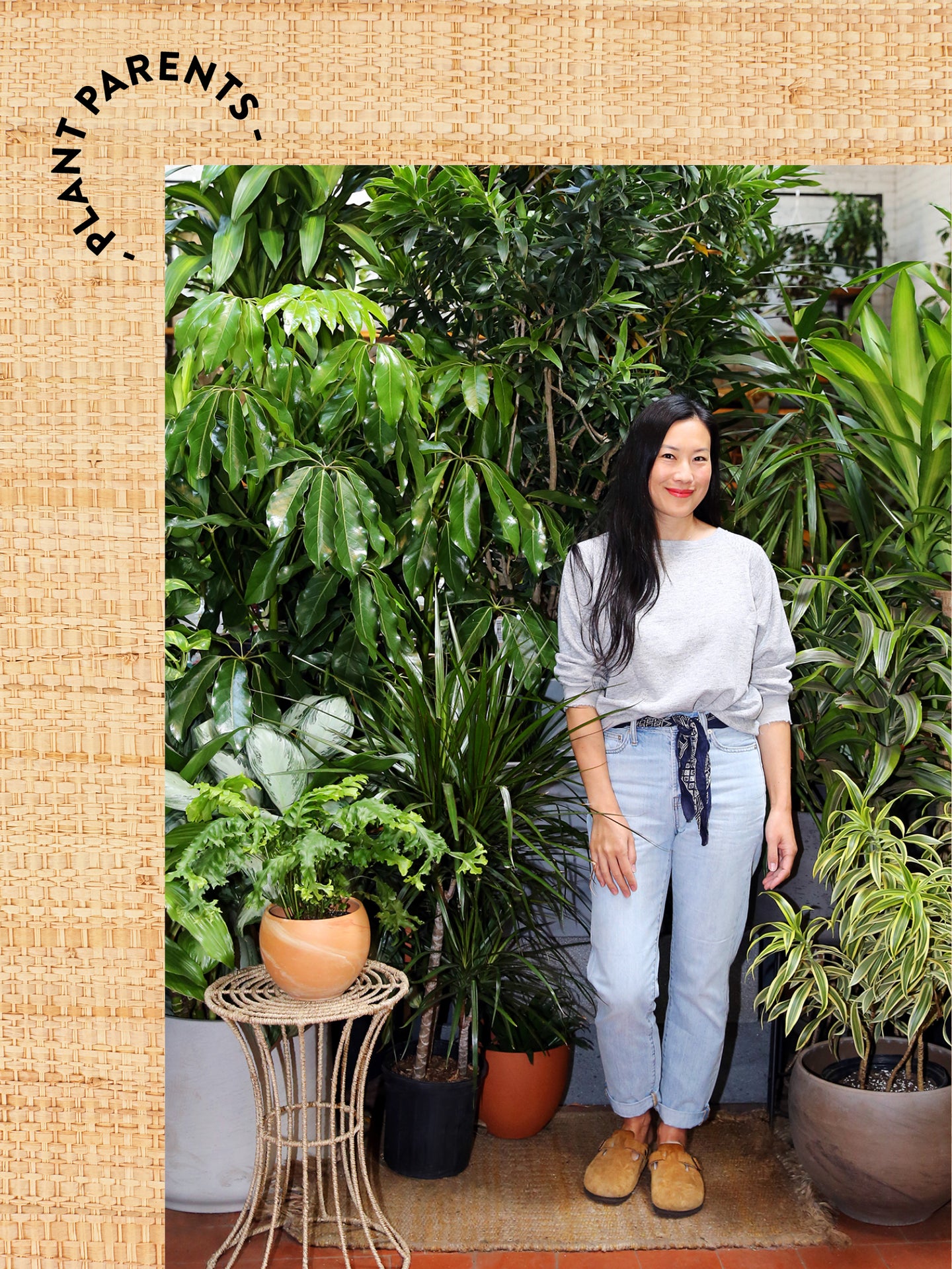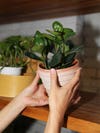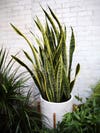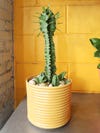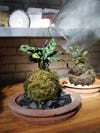Madewell’s Joyce Lee Shares Her Winter Plant Hit List
To every houseplant there is a season—here’s what to stock up on now.
Updated Oct 11, 2018 4:17 PM
We may earn revenue from the products available on this page and participate in affiliate programs.
Finding that corner with optimal sunlight, the perfect pot, and the trick for guiding a little sprout to its full, wild potential—is there anything more gratifying than helping a leafy, living thing thrive? In our new Plant Parents series, we spotlight flora lovers and their tips and tools for raising happy, healthy buds and blooms.Madewell’s head of design, Joyce Lee, has never not been surrounded by plants. “My mom is a gardener, so I grew up in a house filled with an abundance of plants and fruit trees and beautiful flowers in the backyard,” says Lee, whose apartment in Williamsburg, Brooklyn, mirrors her childhood California home. “I love how plants can make the air so fresh and clean while instantly transforming a space into a mini greenhouse, desert, or tropical oasis,” she adds. “I’m also obsessed with pottery, and pots are a great way to bring more color, texture, and personality into a room.” While working on a terrazzo-inspired print for Madewell, Lee came across the Australia-based home line Capra, and the like-minded brands decided to collaborate on a capsule collection of graphic plant accessories in earthy hues (Lee’s top pick: the terrazzo pots, naturally).
When it comes to cultivating her own leafy sanctuary at home, the mom of two (plus 12-year-old cat, Panda) lets pragmatism lead: A plant needs to be kid- and kitty-approved, stay low on the maintenance scale, and create a statement. Lee craves a plant refresh now that winter is almost here and the family is spending more time indoors, so she stopped by her favorite neighborhood shop, Sprout Home, to chat with plant guru Chris Gully; she also shares her houseplant hit list with us.
PEPEROMIA (AKA RADIATOR PLANT) “I love this one for its cute, round leaf shape,” says Lee. Known as the radiator plant for its ease in adapting to the nuances of a typical apartment, it’s also a favorite of Gully’s. “They generally do better in bright, filtered light, but they’re really easy, adaptable creatures. They don’t mind going a bit dry in between waterings, too,” he says. They’re also nontoxic (aka pet- and child-friendly) and can survive forgetful caretakers. “You’re able to bring them back from near-death more than most other types of plants,” Gully adds.
SNAKE PLANT Striking to look at—“I love how nice and vertical they are and the tropical feel they give off,” says Lee—snake plants are also excellent air purifiers and extremely sturdy. “They grow in low, medium, and high light, and can take the extremes of no light or full sun,” says Gully, adding that they should be watered like your average succulent (i.e., left to go almost entirely dry between sessions).
SPIDER PLANT Have a bathroom with a skylight or a frosted-glass window that’s begging for a bolt of leafy green? A spider plant (another air purifier) is a great bet. “They love humidity and are very responsive to light, but if they get forgotten about in their watering habits, they look a lot weaker and they can’t bounce back as easily,” says Gully. “I also keep spider plants in my home because they’re nontoxic for cats,” adds Lee. “Panda was a backyard kitten who still loves to eat anything leafy and green, so it’s always something that I keep in mind.”
AIR PLANT Air plants are as loved as they are misunderstood. “There’s a lot of misinformation out there about how they should be taken care of,” explains Gully. He says they don’t work with any soil mediums—“You could technically add some to them, but you would just need something like an orchid mix,” he clarifies—and they’re always going to do better in a bright, ambient-lit location versus direct sun or low light. Watering air plants means soaking them: “Dunk them in filtered water for five minutes, or up to an hour for the really big ones, then let them dry upside down,” says Gully. Lee has them sprinkled throughout her apartment: “They’re so versatile because you can plop them anywhere!”
CACTI Lee’s California upbringing means she has always had a particular affection for tropical and native desert plants. “My mom thinks I lived in a Moroccan desert in a past life,” Lee says with a laugh. While cacti remain her absolute favorite plant family, having a baby and a roaming toddler has meant keeping the prickly plants to a minimum for now. “I have a few smaller cacti that I keep high on shelves,” she adds. Gully advises city dwellers to remember that these plants need minimal watering but as much sun as possible. And be mindful of your planter: “Cacti have a very tiny root system taking in water, so if you give them a big container, they’re going to take forever to dry out between waterings, in which case you’re rotting out your plant.”
KOKEDAMA Not a plant but a style of planting, this low-lift option is perfect for the green-thumb novice. “It’s essentially just moss wrapped around the root system of a plant into a ball, then wrapped with twine and suspended,” says Gully, adding that watering is done by simply soaking the ball itself. Lee sees kokedama as a great objet: “Mine is a fun hanging piece that has so much character.”
TERRARIUM It doesn’t get much more low maintenance than this. “Terrariums are basically like a little ecosystem enclosed inside a vessel of your choice,” says Gully. Lee is a huge fan: “The one I have is a special glass piece made by the artist Twiggy Lee that’s completely enclosed and filled with cacti and succulents,” she says. “It’s a mini desert in my apartment.”
DRIED FLOWERS Lee incorporates dried flowers (in earth tones and natural hues) into her apartment plantscape because they bring a very different vibe into the mix. And, she points out, they require little to no care. Gully says what’s key to maintaining their integrity is keeping them far away from any moisture or humidity.
Our Plants, Our Selves: Joyce Lee
Plant I’ve had the longest A cute little hylocereus cactus that sits by the window that I’ve had for five years. Even when I occasionally forget to water her, she forgives me.
The most chill plant in my home I have to admit I have a couple of fake plants. They look so realistic nowadays! My mom always kept a couple of larger fake plants in the house, which, at the time, I found a bit strange, but now, as a working mom, I totally get it.
The drama queen I have a Chinese money plant that is so cute, but she needs a really precise amount of watering to keep her happy.
The one I couldn’t save Too many to name! I did have the most incredible cereus cactus that was about five feet tall. I thought it would be in my home forever, but sadly it just wasn’t getting enough direct light so it didn’t make it.
Favorite plant playlist I love “Bam Bam” by Sister Nancy. It makes me feel like I’m on a chilled-out tropical vacation.
Best plant to gift Air plants are perfect! What’s better than no soil?
And some winter plant advice… As we shift into colder weather, it’s wise to make some seasonal considerations with your plants, too. Because we aren’t receiving as much natural light in the winter months as we do in spring and summer, you should be watering plants less frequently, says Gully. Tropical plants respond poorly to drastic temperature changes, so if you own a number of them Gully suggests grouping them together so they can help humidify each other. Incorporating a regular misting routine or adding a humidifier to your space can also do the trick. And because many plants’ growth cycles become dormant in the winter, don’t create further disruption by up-potting, down-potting, or replanting until the warmer months. Finally, his most important (and evergreen) advice: Be intuitive about your own plants. Mama and Papa know best!
More Plant Parents: Domino’s Executive Creative Director, Kate Berry, Grew a Garden in the Sky Every Sprout Thrives at This California Creative’s Magical Redwood Home Everything in Our Kit for New Plant Parents Is on Amazon
